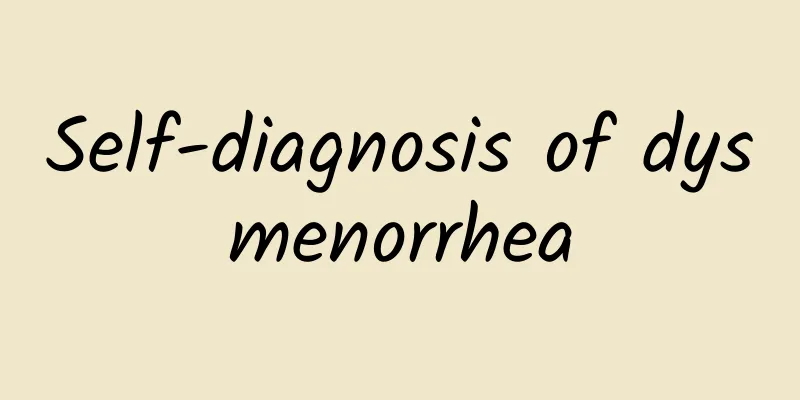Self-diagnosis of dysmenorrhea

|
Women experience pain in the lower abdomen and lumbosacral region before, during, or after menstruation. In severe cases, the pain is severe, the face turns pale, the hands and feet are cold, and even fainting occurs. This is called "dysmenorrhea" or "menstrual abdominal pain". The pain often lasts for several hours or 1 to 2 days. Generally, the pain is relieved after the menstrual blood flows smoothly. Some women experience pain after menstruation. Dysmenorrhea is one of the common diseases among women. The following is an introduction to the self-diagnosis and treatment of dysmenorrhea. The first record of pain syndrome was found in Suwen. Jutonglun: "When cold air enters the meridians, it is delayed and unable to move. If it stays outside the meridians, there will be less blood. If it stays inside the meridians, the qi will not flow, so the pain will occur suddenly." This explains the pathogenesis of pain caused by obstruction; Chao Yuanfang of the Sui Dynasty listed "menstrual abdominal pain symptoms" in Zhubingyuanhoulun, explaining the cause of dysmenorrhea, believing that it is caused by "exhaustion of blood and qi, resulting in physical weakness, wind and cold air invading the cell network, and damaging the Chong and Ren meridians." Chen Ziming of the Song Dynasty gradually realized in Furen Liangfang Daquan that the pathogenic factors of dysmenorrhea are not only cold, but also qi stagnation and blood stasis. In the Ming Dynasty, Zhang Jingyue gave a more detailed explanation of the causes of dysmenorrhea: "Abdominal pain during menstruation has two types of symptoms: deficiency or excess. Excessive symptoms may be caused by cold stagnation, blood stasis, qi stagnation, or heat stagnation; deficiency symptoms include blood deficiency or qi deficiency." Modern Chinese medicine believes that the causes and pathogenesis of dysmenorrhea mainly include qi stagnation and blood stasis, stagnation of cold and dampness, qi and blood deficiency, and liver and kidney deficiency. Traditional Chinese medicine professionals can make a correct diagnosis and provide treatment based on the patient's clinical manifestations, but how can non-professionals know what type of dysmenorrhea they have? You can make a judgment from the following aspects: 1. Determine the nature of dysmenorrhea: (I) Distinguish between deficiency and excess based on the duration of pain: 1. Pain before and during menstruation is generally a positive symptom. If it is pain during menstruation, the pain stops after menstruation, and it is often a mixture of positive and negative symptoms. 2. Postmenstrual pain is generally seen in deficiency syndrome. (II) Identify Qi and blood based on the location of pain: 1. Pain in the middle of the lower abdomen is mostly caused by blood stasis or blood deficiency; 2. Pain on both sides of the lower abdomen is usually caused by qi stagnation; (III) Distinguish between deficiency and excess based on the nature of pain: 1. Refusing to press the lower abdomen due to pain is a positive sign; 2. The pain is felt by pressing or kneading the lower abdomen with hands, which is usually due to deficiency syndrome; (IV) Distinguishing Qi and Blood from the Nature of Pain and Distension: 1. During menstruation, if the degree of lower abdominal distension is greater than pain and accompanied by breast pain, it is mostly due to qi stagnation; 2. During menstruation, if the pain in the lower abdomen is greater than the bloating, or there is no bloating at all, it is mostly due to blood stasis; (V) Distinguishing Qi and Blood from the Feeling of Pain: 1. The feeling of needle-like pain is mostly caused by blood stasis; continuous cramping pain is mostly caused by blood stasis; 2. Twisting pain in the lower abdomen is mostly caused by cold and blood stasis. 3. Paroxysmal pain is mostly caused by qi stagnation and blood stasis. (VI) Dialectics based on the color of menstrual blood: 1. Lower abdominal pain before or during menstruation, scanty menstruation, poor flow, dark purple blood with blood clots, or membrane-like substances, pain relief after the blood clots are discharged, mostly due to qi stagnation and blood stasis; 2. Cold pain in the lower abdomen before or during menstruation, scanty menstruation, dark blood and clots. Most of them are caused by stagnation of cold pathogen; 3. Sustained lower abdominal pain during or after menstruation, less menstrual volume and lighter color like meat soup. This is mostly due to weak qi and blood; 4. Dull pain in the lower abdomen after menstruation, or dizziness and backache, scanty menstrual flow, and light color. This is often seen in liver and kidney deficiency. Diet therapy can play a better preventive and therapeutic role. 2. Symptomatic treatment of dysmenorrhea: Dysmenorrhea of positive syndrome is usually severe and may even cause painful syncope. At this time, pain relief should be the main principle. For chronic cases, simple Chinese patent medicine can be selected. 1. Seek medical attention promptly. 2. If you cannot seek medical attention immediately, you can drink a cup of warm brown sugar water first. Massage the lower abdomen and Zusanli acupoints; 3. Heat the salt and wrap it with a towel to apply to the lower abdomen. (Be careful not to burn the skin) 4. Take any one of the following orally: Motherwort Granules, Yueyueshu Granules, Tianqi Dysmenorrhea Capsules, etc. You can also take painkillers, ibuprofen, and other Western medicines orally; 5. If you have lower abdominal pain during menstruation accompanied by breast pain, you can take Xiaoyao Pills; 6. For dysmenorrhea caused by deficiency of qi and blood, you can choose Agui Yangxue Paste. After the menstruation is over, you can take Wuji Baifeng Pills, Donkey Glue Blood-Replenishing Granules, etc. 7. For dysmenorrhea caused by liver and kidney deficiency, you can choose Agui Yangxue Paste. After the menstruation is over, you can take Wuji Baifeng Pills, Liuwei Dihuang Pills, Guilu Bushen Pills, etc. (depending on the results of the syndrome differentiation of kidney yin deficiency and kidney yang deficiency); 3. Daily health care: 1. The diet should be light and easy to digest within 3 to 5 days before menstruation. 2. Eat foods that are easy to digest and absorb, and do not eat too much. In particular, avoid eating raw and cold foods, because raw and cold foods can stimulate the contraction of the uterus and fallopian tubes, thereby inducing or aggravating dysmenorrhea. 3. Stay optimistic and don’t get angry when things don’t go your way; 4. Try to avoid washing your hair at night; 5. When menstruation comes, try to avoid all raw, cold, indigestible and irritating foods, such as peppers, raw onions, raw garlic, pepper, strong alcohol, etc. During this period, patients can eat some sour and sweet foods, which can relieve pain. 6. Based on the results of dialectics, appropriately increase the amount of food that can activate blood circulation, dispel cold, replenish blood, invigorate Qi, and nourish the liver and kidneys in your daily diet. Self-treatment of dysmenorrhea is only a temporary measure. After the pain is relieved, you must go to a medical institution to see a doctor for treatment in time. As for the dialectical method of cold, heat, deficiency and excess, it is only a superficial part. Many people with dysmenorrhea often have multiple causes for one disease, with both deficiency and excess, so it is advisable to diagnose and treat it in time. |
<<: How to prevent dysmenorrhea before menstruation
>>: Go to the hospital to check the process of dysmenorrhea
Recommend
What are the symptoms of uterine fibroids and what are the treatments for uterine fibroids
1. How do uterine fibroids occur? Traditional Chi...
Uterine ischemia and hypoxia in women is one of the causes of dysmenorrhea
Experts say that women's dysmenorrhea mainly ...
Click on "food" to turn into gold! 333 Guidelines for eating out to stay healthy
The number of people eating out in Taiwan has con...
What causes cervical warts
What causes cervical warts? Although medical stan...
What is a giant uterine leiomyoma? Definition of a giant uterine leiomyoma
What is a giant uterine leiomyoma? Definition of ...
Revealed: The reason why candidal vaginitis recurs
According to the latest survey data, many patient...
How to treat abnormal leucorrhea with foul odor
Abnormal leucorrhea with a foul odor may be a sig...
Three dietary prescriptions for patients with functional uterine bleeding of different constitutions
Dysfunctional uterine bleeding is classified as &...
Analysis of the preparations before artificial abortion
Abortion is something that women are very relucta...
Common symptoms of vulvar leukoplakia
People need to know the obvious manifestations of...
There are many things women should pay attention to after painless surgery.
There are many things to note when having an abor...
Foods you can and cannot eat to lose weight - a reference for people who want to lose weight
When it comes to weight control, diet control is ...
Does medical abortion hurt? What should I pay attention to during medical abortion?
Many young women, out of their desire for sex, ha...
What is the severity of cervicitis?
Severe cervicitis may develop into chronic cervic...
Is it okay to walk when your vulva is itchy?
Many women are busy with many things, so some rel...









